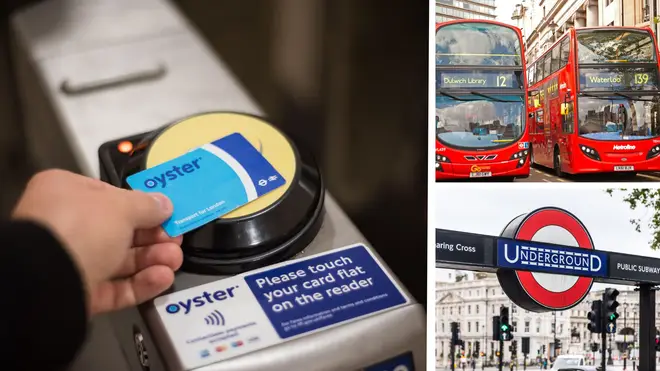
Oli Dugmore 4am - 7am
1 December 2022, 15:04 | Updated: 1 December 2022, 15:51

Tube and bus users will be paying £6bn annually in fares to Transport for London under new plans to break even, it's been reported.
TfL's annual income from fares to rise by £1.7bn - or 40 per cent - over the next three-and-a-half years
TfL finance chiefs are expecting annual income from fares to rise by £1.7bn - or 40 per cent - over the next three-and-a-half years.
The increase is driven partly by increased passenger numbers and partly by annual price rises.
Under the local government body's final bailout deal last August, the Government expects TfL fares to increase by at least four per cent next March, in line with national rail fare prices, and rise by the same amount again in January or March 2024.
In the 2024/25 and 2025/26 financial years, TfL’s planning assumption is for a yearly hike one percentage point above the RPI rate of interest.
Read more: Boris Johnson confirms he will stand again as an MP at the next election
Read more: St Ives is Britain's happiest place to live: Full list revealed
However, London Mayor Sadiq Khan will have the final say on each annual fares review and can decide his own figure.
Tfl's £6bn fares projection features in its new business plan, which outlines expected income and spending until 2025/26, The Evening Standard reported.
Key elements of the plan include:
The business plan, which is first since 2019, looks to position TfL as the “green heartbeat of London” by prioritising schemes to reduce pollution and improve the environment.
In its first 12 months, the expansion of the ultra-low emission zone to the Greater London boundary next August is set to raise £200m in income.
But the income is expected to drop sharply in the following years as road users switch vehicles so they don't have to pay the £12.50 levy.
About £150m will be spent annually on cycling and walking schemes, as it aims to bring down dependency on cars and increasing the proportion of journeys that are cycled, walked or made by public transport from 62 per cent to 68 per cent by the decade's end.
TfL commissioner Andy Lord told the Standard the plan should reassure Tube unions on staff pensions.
“We have not assumed any savings from any changes to pensions at all in the period of this business plan,” he said.
However, the removal of up to 600 Tube station posts has started – one of the issues behind the six Tube strikes by the RMT this year - but without redundancies.
Tfl's plan sees it breaking even during 2023/24 but still requiring help from the Government for “big ticket” projects such as the Bakerloo line extension.
Its borrowing is expected to rise to £14 billion.
Mr Lord identified “four clear priorities”: winning back passengers, making TfL a “simpler and more effective organisation”, rebuilding its finances and taking a lead on confronting the climate crisis.
Currently, passenger number are at 80 per cent of normal levels, though Tube travel on Mondays and Fridays is lagging as work habits have changed.
TfL says it's offering a “relatively prudent set of projections” on demand due to uncertainty about the economy, the cost of living crisis, the impact of Brexit and the war in Ukraine.
Over the lifetime of the plan, Tfl plans to pump £8.1bn into improving London's road, Tube and rail network.
New air-conditioned trains appear on the Piccadilly line from 2025, while new longer DLR trains are planned to be introduced from 2024.
“Active discussions” are taking place with the Government about the long-term ambition' of to replace ageing trains on the Central line and Bakerloo line and extending the DLR to Thamesmead.
Mr Khan said: “The past two years have been the most challenging in TfL’s history and the pandemic’s impact on TfL’s finances was devastating.
“It is clear there are many challenges ahead, but TfL’s business plan sets out how London’s world-class public transport network will continue to contribute to a better, greener and fairer city for all Londoners.”
However, Aslef, the main Tube drivers’ union offered no indication that TfL's “olive branch” on pensions would stop more strikes.
Finn Brennan, Aslef’s organiser on the London Underground, said: “This demonstrates again that the insistence by the government that TfL change its pension scheme is driven entirely by political vindictiveness.
"The TfL pension fund is extremely healthy, well managed, and in surplus. There is no justification for detrimental changes and Aslef will oppose them by all possible means.
“We have started the proceed of re balloting our members across London Underground for industrial action in the New Year if there is an attempt to push changes to pension or working practices through without agreement.”